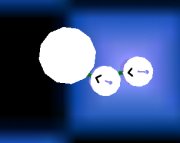Evolution of Solitary and Group Transport Behaviors for Autonomous Robots Capable of Self-Assembling
by Roderich Groß and Marco Dorigo
Abstract
Group transport is being performed in many natural systems
and has become a canonical task for studying cooperation in
robotics. We simulate a system of simple, insect-like robots
that can move autonomously and grasp objects as well as each
other. We use artificial evolution to produce solitary
transport and group transport behaviors. We show that
robots, even though not aware of each other, can display
effective group transport behaviors. Thereby, they can
benefit from behaving differently from robots engaged in
solitary transport. The best group transport behaviors
yielded by half of the evolutions let the robots organize
into self-assembled structures. This provides evidence that
self-assembly can provide adaptive value to individuals that
compete in an artificial evolution based on task
performance. We conclude the paper by discussing potential
implications for evolutionary biology and robotics.

Video Recordings (copyrights are with Roderich Groß)
Group transport of a heavy prey (1250g) by 5 robots:
- self-assembling behavior - evolved neural network controller that lets robots self-assemble:
Video 1 (2.3 MB)
(robots capable of group transport)
Video 2 (6.1 MB)
(interesting behavior)
- non-self-assembling behavior - evolved neural network controller that does not let robots self-assemble:
Video 1 (2.2 MB) (robots incapable of group transport)
References
- Groß R. and Dorigo M., Evolution of Solitary and Group Transport
Behaviors for Autonomous Robots Capable of Self-Assembling, Adaptive
Behavior (accepted for publication)
- Groß R. and Dorigo M. Evolving a Cooperative Transport
Behavior for Two Simple Robots, In Liardet P., Collet P., Fonlupt
C., Lutton E., and Schoenauer M., editors, Artificial Evolution -
6th International Conference, EA 2003, Revised Selected Papers,
volume 2936 of Lecture Notes in Computer Science, Springer Verlag,
Berlin, Germany (2004) 305-317
© 2003-2007 Roderich Groß

